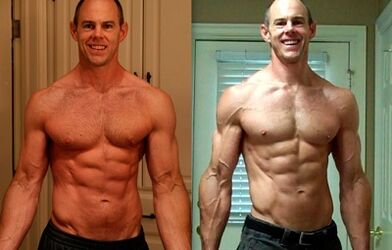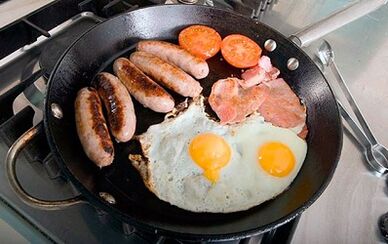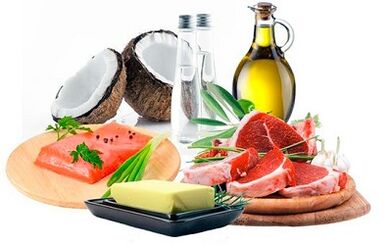
Many people who control their weight have noticed more than once that they quickly lose several kilograms just by temporarily giving up flour, sweets, potatoes and cereals.This is due to rapid carbohydrate restriction.Without getting its usual daily dose of glucose, the body begins to look for other sources of energy and turns to fat and protein.
Restriction of carbohydrate foods is a main principle of the well-known low-carb diet.But in addition to the sensational Kremlin diet and Atkins diet, there is another nutritional system that is stricter, but at the same time more effective - the ketogenic diet.
Keto diet, what is it?
The keto diet is a protein-fat diet that is almost completely free of carbohydrates.This is one of the few diets known in our time that can eliminate subcutaneous fat while maintaining muscle mass.The main goal of the keto diet is to force the body to quickly switch from glycolysis to lipolysis.Glycolysis is the process of breaking down carbohydrates, and lipolysis is the process of breaking down fat.The latter is only triggered when glycogen stores in the liver and muscle tissue are completely depleted, usually within a few days.During lipolysis, fats are broken down into free fatty acids and glycerol, which are subsequently converted into ketone bodies.The process of ketone body formation is called ketosis, hence the name of the diet itself.
Body Adaptation to Ketosis and Diet Duration
Unlike regular low-carb diets, the ketogenic diet is longer and more systematic.During the first week, the body adapts to the changes through dietary reserves, and only toward the second week does subcutaneous fat begin to burn.
The body prepares itself for ketosis in four stages:

- total glucose consumption.During the first 12 hours after your last meal, the body uses the glucose it gets from carbohydrates;
- Glycogen is completely depleted.Within 12 hours, the body manages to process all the glucose and begins drawing glycogen stores from the liver and muscles.This stage lasts approximately 1-2 days;
- Fat and protein consumption.This is the most difficult period because after depleting all carbohydrate stores, the body not only starts processing fatty acids but also tries to produce the required amount of glucose from protein.During this phase, the body attempts to use protein, including muscle protein, as its primary source of energy;
- Ketosis, fat consumption.This phase occurs around day 7 of the diet.The body adapts to the lack of carbohydrates and ketosis begins.The breakdown of protein in yourself and in food slows down, and fat ends up becoming the main source of energy.
The ketogenic diet can last 2 to 3 weeks, depending on your goals.During the first week, the body stores up and adapts to the new diet, and only from the second week does ketosis begin, so if you plan to reduce the amount slightly and only take it for a few days, then the keto diet is not for you.In this case, it's better to consider the simpler and more common low-carb diet.It is very important to exit the ketogenic diet correctly and gradually return to a normal diet, adding no more than 30 grams of carbohydrates per day.
Who is suitable for the ketogenic diet and who is contraindicated?
In order to function properly, the body requires three major nutrients: protein, fat, and carbohydrates.
They are found in regular foods and each perform their own function:
- Fat is a hard barrier for internal organs and may accumulate under force majeure conditions;
- Protein is the primary building material for muscles, joints, and the entire body.Without it, you will never be able to build muscle and build a beautiful, sculpted body.These organic substances are vital for professional athletes and anyone with an active lifestyle;
- Carbohydrates are the main source of energy.They are the ones who bring us life and vitality.
Proteins, fats, and carbohydrates are equally useful and necessary when they are introduced into the body in moderate, proportional amounts.This is why people who are active in exercise and control their diet will never have problems with being overweight.But if a person leads a sedentary lifestyle, often overeats or eats randomly, and often indulges in fast food, candy and other sweets, it will cause excessive fat and carbohydrates in the body, which will gradually be converted into subcutaneous fat.The ketogenic diet will help you lose excess weight and "cleanse" your body of excess fat.It will appeal to people who have difficulty restricting their food and counting calories.Also indispensable for athletes during dry periods.Before starting this diet, it's important to consult a nutritionist and get a thorough physical exam.The ketogenic diet can lead to real positive results, but only if the person is healthy.
The keto diet is strictly prohibited for diabetics, pregnant women, people with thyroid disease, and people with kidney, liver, and gastrointestinal problems.
Pros and cons of the keto diet

Benefits of the keto diet include fast and effective weight loss.The decrease in the number on the scale is not due to fluid or muscle, but to the breakdown of fat.While on the ketogenic diet, you don’t have to fast or constantly count calories.Of course, regulating food intake is necessary, but the ketogenic diet is not based on reducing calories, but reducing carbohydrate foods as much as possible.Thanks to the ketogenic diet, you can eliminate fat while maintaining muscle.
The main disadvantage of the keto diet is its imbalance.Eliminating carbohydrates means reducing vitamins, beneficial trace minerals, and fiber – essential ingredients for cleansing the body and the proper functioning of the stomach.The lack of vitamins can be compensated by drinking a vitamin complex at the end of the diet, but the situation is more complicated if fiber is present.Its deficiency can lead to damage to the intestines and kidneys, so it is recommended to consume fruits, vegetables and bran in small amounts during the diet to minimize the risk of serious diseases.The main thing is not to overdo it and make sure that you do not consume more than 50 grams of carbohydrates per day.
Restricting carbohydrate intake can have adverse effects on mental and physical abilities, reducing activity and concentration.This is especially true for people who engage in creative or intellectual activities.This period is often accompanied by increased fatigue, lethargy, and mild apathy.
What can and cannot eat during the ketogenic diet?
Most of the diet during the ketogenic diet should contain protein foods:
- meat (beef, veal, rabbit, poultry and even pork);
- Fish (especially herring, salmon, salmon, tuna);
- Seafood (mussels, shrimp, crab, squid, etc.);
- eggs (chicken and quail);
- Nuts (hazelnuts, almonds, pistachios);
- Skim milk 0.5 -1.5% fat;
- Low-fat fermented dairy products (cheese, yogurt, kefir) free of dyes, flavours, fruit additives and sugar;
- Small amounts of low-starch vegetables, lettuce, and unsweetened fruits (sour apples, oranges, grapefruit).
In order to create the right keto diet menu, it is important to understand not only the allowed foods, but also the foods that are strictly prohibited:

- bread;
- Potato;
- cereals;
- banana;
- Grape;
- sugar;
- chocolate;
- Sweets (pastry, cakes);
- Any baked goods or homemade baked goods.
Based on these two lists and checking the energy value table of the products, you can easily create a menu for a week, two weeks or more and stick to it.These energy table data are needed to control carbohydrates.When writing your menu, you need to make sure that its quantity does not exceed the 50g mark.every day.
Menu example
breakfast.Omelet, two eggs, spinach, half a grapefruit, unsweetened tea.
dinner.A lighter version of homemade Caesar salad.It should consist of green lettuce leaves and boiled chicken breast.You can dress the salad with olive oil or lemon juice.You can't add croutons or sauce that are commonly found in recipes.
dinner.Trout steak grilled in foil.
Few people decide to try the ketogenic diet, mainly because it breaks established stereotypes.Many people use the word "diet" to mean strict calorie counting, restrictions on fatty foods, meat, and the transition to so-called "pasture."On a ketogenic diet, everything is exactly the opposite.The diet excludes most fruits, vegetables and grains and introduces eggs, seafood, fish and meat, including fatty varieties.






























